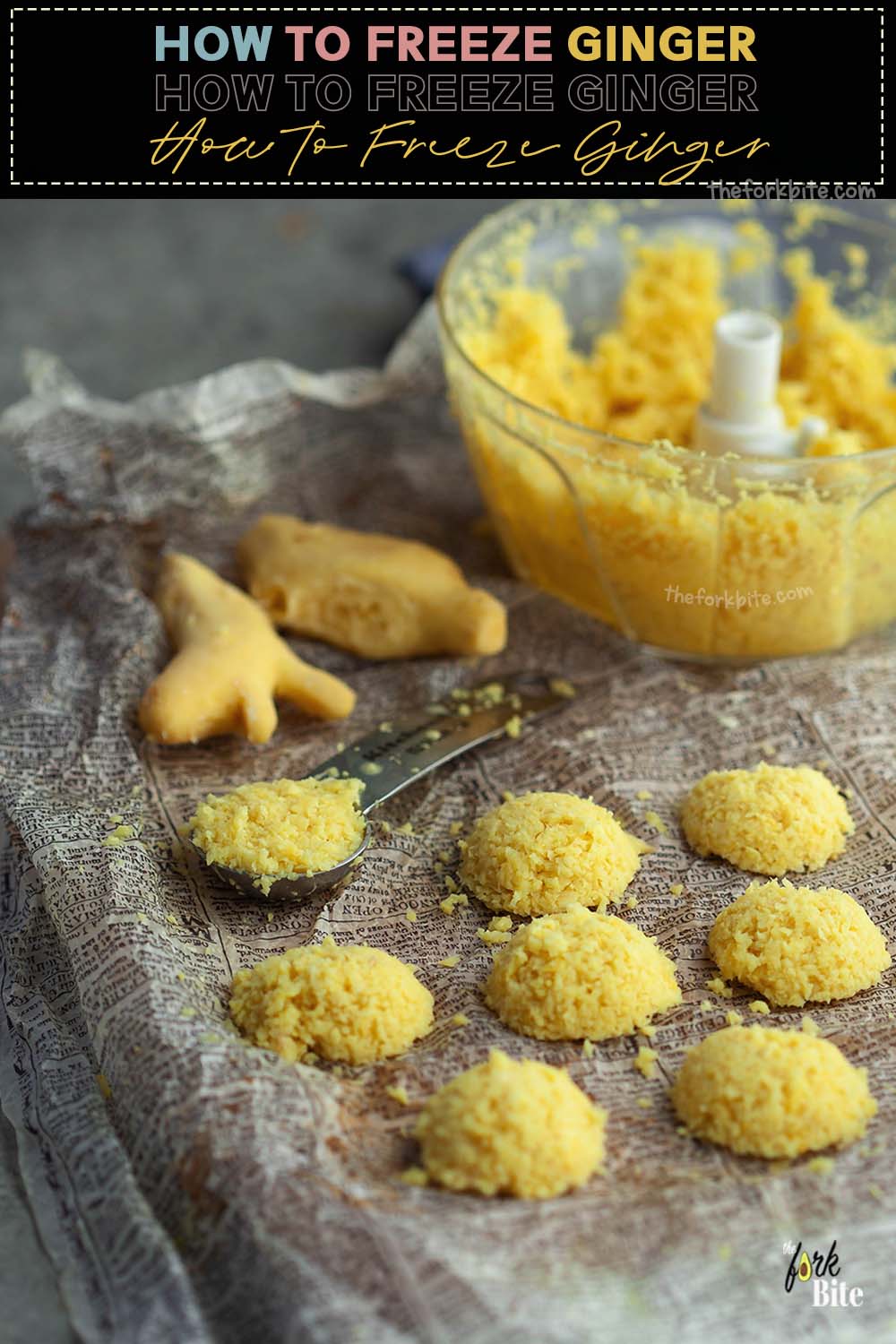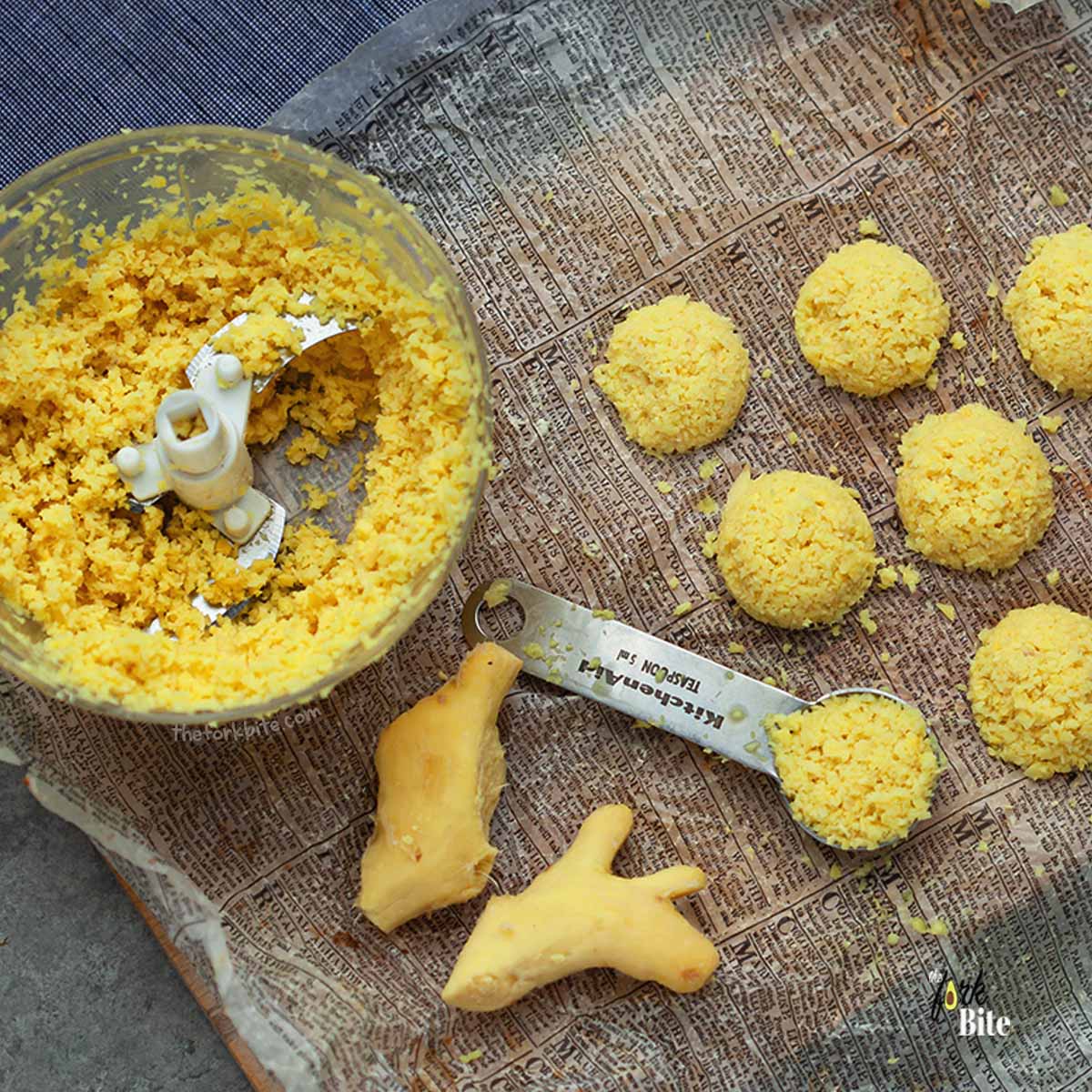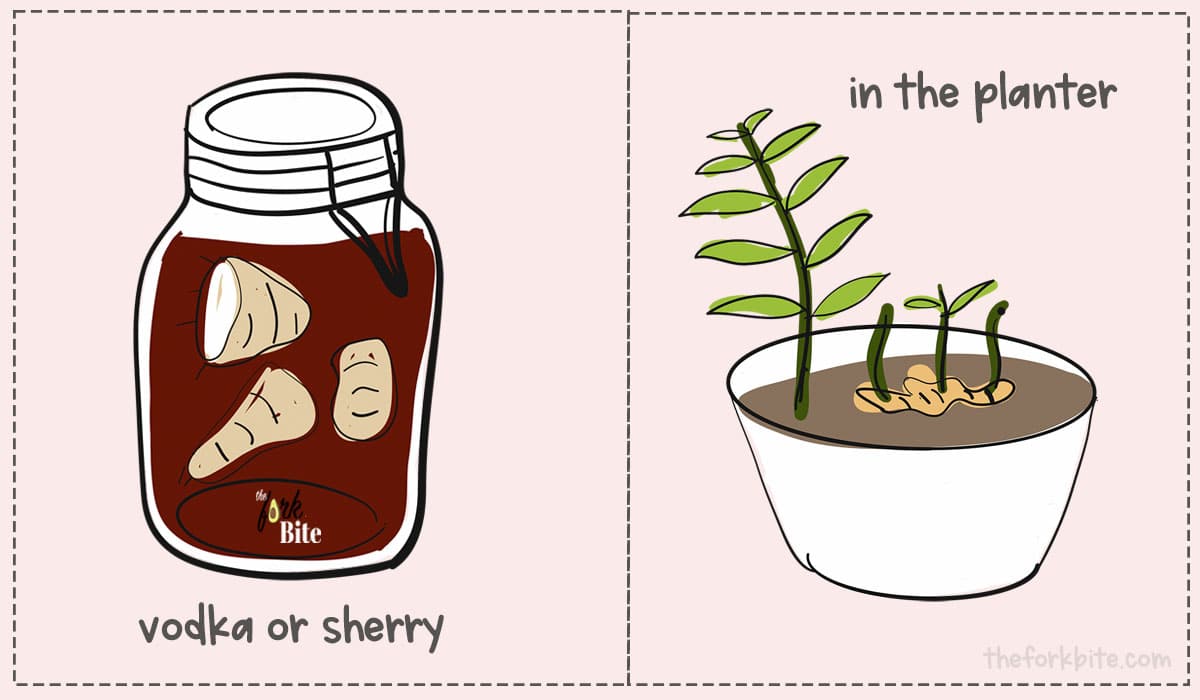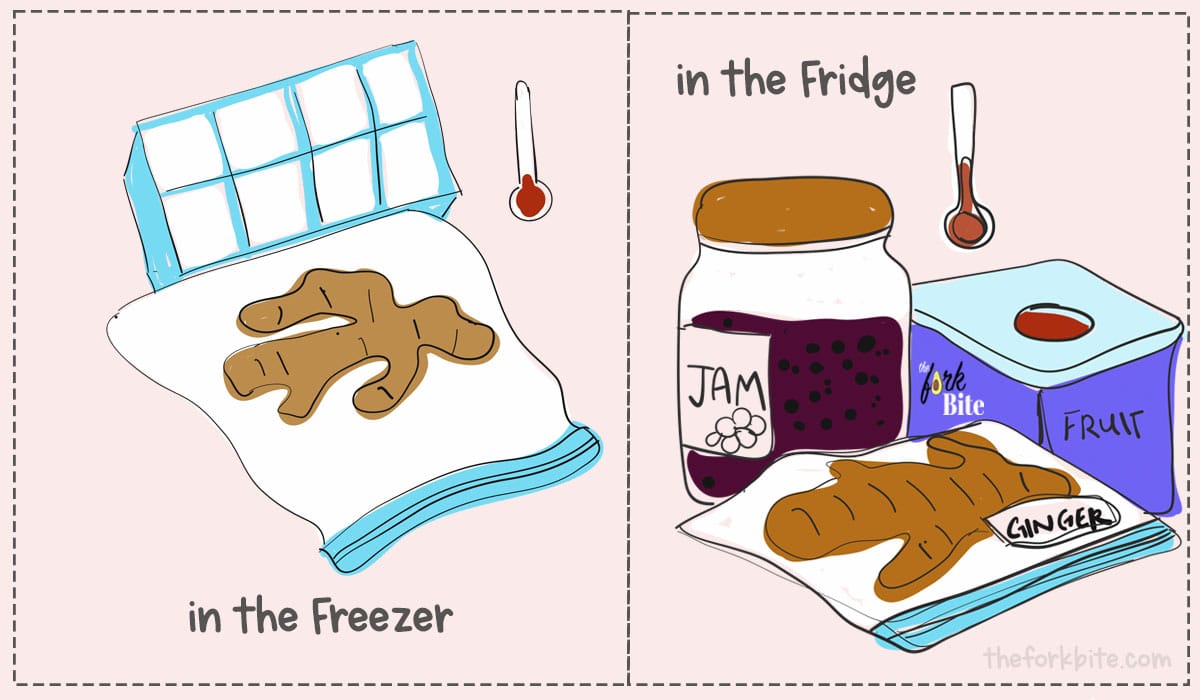How to freeze ginger? Freeze fresh ginger by sealing it tightly in an airtight, freezer-safe Ziplock bag or container. As a chef, you are likely to come across ginger in two forms - fresh and ground.
Fresh, root ginger has a distinctive, strong, spicy taste, quite different from ginger in its powder form when it is a lot milder and slightly sweet tasting.
Fresh root ginger imparts a distinctive hit of flavor to a wide variety of dishes.
The only problem with ginger in its root form is that it doesn't keep for more than three weeks at room temperature or even in a fridge.
It goes off relatively quickly, shriveling and rotting in the process. If you cut a small portion to use and leave the remainder behind with an exposed surface where the cut was made, it only accelerates the rotting process.
However, all is not lost. You can extend the life of fresh ginger by freezing it, and it's not difficult to do.
Watch the Video
How to freeze ginger
- The best way of freezing fresh ginger is by sealing it tightly in an airtight, freezer-safe Ziploc bag or container.
- When picking out ginger you intend to freeze, choose the freshest you can find. Look for large and bulbous pieces with smooth skins, and that have a nice fragrance. Avoid anything thin and wrinkled.
- It's not essential to either peel or chops the ginger before you freeze it. However, if you know that you will be using it in certain sized pieces for recipes you intend to make, it's best to pre-cut it as you will find it easier when you come to use it.
- Once cut, put the pieces of ginger into bags or containers, label them with a description of the contents, the amount.
- And if appropriate, the size and the date you began the freezing process. It just makes it easier to identify when you come to use it.
You haven't bought fresh ginger yet.
When you get back home from the store with your fresh ginger, peel it at your earliest convenience. It's the sort of chore that is easily put off to the next day.
The trouble is you can keep on doing that day after day, and in the meantime, the ginger is losing its freshness. So it's better if you resolve to do it straight away.
As soon as you have peeled it, put it into the freezer.
Why, you might ask yourself?
It's because frozen ginger is far easier to grate than fresh ginger. Ginger root is quite fibrous, which means grating can be a bit of an art. However, when it's frozen, it is far easier to grate.
You can either use the tiny holes or the medium holes in your box grater for the actual grating process. You can even Microplane it.
The choice is yours, but it should be dictated by the size of the pieces you wish to use in the recipes you will be preparing.
I prefer grating it with tiny holes, but that's because I tend to use it in recipes calling for finely cut or grated ginger. The choice is yours.
***Then continue with the general method below.
You already have fresh ginger at home.
If you've already got some fresh ginger leftover at home and it is as yet un-peeled, peel it as finely as you can.
Peeling it too deeply will result in losing too much ginger. Once peeled, put it straight in the freezer overnight, and it will be perfect for grating in the morning. If you peel it and leave it out, it will start to turn brown and dry out.
Having prepared it by peeling, you now need to decide how best to go about freezing it.
3 ways to freeze ginger
Option 1 Freeze in ice cube trays
Recently, I bought an ice cube tray made out of silicon from my local Aldi store. While it's great for making ice cubes (the purpose for which it was designed), I also find that it can be used for freezing ginger, and here's how:
- Cut the ginger into teaspoon and tablespoon sizes pieces. Place in a blender or mini food processor (or a Microplane grater). Transfer the grated ginger and push it into the recesses of the ice cube tray. Firmly press it down with your fingertips or spoon to squash the ginger together into the recesses as best you can.
- Freeze it for at least eight hours, after which you can pop the pieces of ginger out and drop them into a Ziploc bag or freezer-safe container ready for future use.
Option 2 Flash freeze on parchment paper
- If you don't possess ice cube trays, or you do, but you'd rather not use them, you can instead cover a cookie sheet with some parchment paper, on which you can then deposit the scooped out pieces of grated ginger.
- Space out the scoops about an inch apart. Place the tray into your freezer for a minimum of eight hours.
- Once satisfactorily frozen, put the ginger pieces into a Ziploc bag or freezer-safe container.
Option 3 The lazy way to freeze ginger
- If you're pushed for time, or you don't have the inclination, there's an even simpler way of freezing ginger. Peel it, and stick the whole thing into the freezer as it is without bothering to cut or grate.
- Don't forget that when frozen, ginger grates easily. All you have to do whenever you need it is grab the whole piece and grate off as much as you need.
Tips for freezing ginger
Size -wise, I like to freeze my ginger in 1 teaspoon increments. It's because they thaw more quickly, making it easier to use when I need it.
For your information, three teaspoons are roughly equivalent to 1 tablespoon. Here are some things of which to be mindful.
- When you grate fresh ginger, it is quite juicy, so when you add it to recipes, you won't need any additional liquid.
- As ginger ages, it becomes dryer. If this is the case, the best way to freeze it is using the ice cube tray idea and adding a drop or two of water to help the pieces to compress and freeze together.
- Don't forget to label the containers. You don't know when you might come to be looking for your frozen ginger, and you might not recognize it for what it is in a few days or weeks. Labeling your freezer containers is just good practice.
- When you peel the ginger, don't throw the peel away. You can use it for flavoring homemade chicken stock.
- You don't have to grate your ginger. If you prefer, you can peel it and cut it into slices. It all depends on the recipes you're going to be putting it into, but if peeling and slicing is your preference, you can cut it before you freeze it. You can, if you wish, flash-freeze the ginger between sheets of parchment paper. But if this seems too much aggravation, then feel free to put it straight into a freezer-safe container.
- Using a vegetable peeler or knife to peel your ginger can be awkward and may lead to significant waste. Additionally, there is always the risk of cutting yourself. A trick that I have learned from professional chefs is to peel ginger with a spoon. You only have to scrape the edge of the spoon across the surface of the ginger, and the skin rubs off quite easily.
If you have little room in your freezer, there are some alternative ways you can prolong the life of your ginger.
- Frozen ginger is best used within six months. It okay to eat after that; however, it won't taste as good.
- Depending on the recipe, you can substitute one form of ginger for another. Instead of fresh, for example, you may be able to use it in either ground or crystallized form.
Keeping fresh ginger in your refrigerator is an easy way of avoiding food wastage. As my mom used to say - waste not, want not.
Using Frozen Fresh Ginger
The decision on whether or not you need frozen ginger depends largely on how you will be using it. If you want to grate it, you can take a piece out of your freezer, then peel and grate the quantity you need.
As ginger is easier to peel and grate when frozen than when fresh, it is not necessarily to thaw it. If there's any ginger leftover, wrap it up tightly and put it back in the freezer.
When a recipe requires slices of ginger, it will be necessary to defrost it first because it is not only difficult to cut frozen ginger with a knife, it can also be dangerous.
If you cut the ginger into small pieces before freezing, you should thaw it before trying to slice it.
Buying Fresh Ginger
If the ginger's quality in your local grocery store is not up to scratch, you could go to an Asian or Indian market where you should find a good quality product in stock.
- Remember when shopping for ginger to look for pieces that have smooth, unwrinkled skin. Skin or peel that is wrinkling means that the ginger is old and drying out.
- Look at the ends to make sure there is no mold. Yes, you can cut the moldy bits out, but once the mold has started, it's sure to come back real quick.
You'll find the freshest pieces of ginger on sale at Asian and Indian grocers. It's usually cheaper too.
Can ginger be stored at room temperature?
If you will be using your ginger within a week of purchase, keeping it at room temperature is fine. You can store it on your worktop or in your pantry unpeeled until the time comes to use it.
But what about peeled or cut ginger?
Once you peel or cut ginger, it's important to wrap any exposed areas with aluminum foil and then transfer it into a sealable container. It will help to stop it from drying out and starting to deteriorate.
How long does ginger root last in the refrigerator?
The best place for storing fresh ginger that has been peeled is in your fridge, where you can keep it for up to about one month. Before refrigerating it, however, it's best if you wrap it in kitchen paper.
Does fresh ginger go bad?
Regrettably, fresh ginger will go bad. Here are the signs to look for:
Use your eyesight. -- If you see small spots of mold appearing, it's time to throw the ginger away. When ginger begins to turn moldy, it will lose its nutritional value, and it will rot rapidly.
If you do spot signs of mold, it's best to throw the whole piece away. You'll be surprised how deeply the mold penetrates the ginger, and if you eat it, you could become ill.
Using your nose. -- Your ginger could be rotting, but the peel remains smooth, unwrinkled, and blemish-free. Unfortunately, it could still be rotting inside, and the way to tell is by sniffing it. The tell-tale signs won't have a strong ginger smell but could be emitting a horrible sharp aroma.
By touch. -- Another way of telling whether or not ginger is deteriorating is by its texture. It should be firm. If it at all soft or mushy, throw it away.
Other ways to store ginger
1 Refrigerator Storage
The best way of storing ginger is to leave its peel intact and keep it in your fridge. You can refrigerate cut ginger but just bear in mind that it won't last as long.
To optimize storage time, put the ginger into a freezer bag, evacuate as much air as you can, and put it in the crisper drawer inside your fridge.
If you're in a rush or don't have any freezer bags, you can put the ginger in your refrigerator in a brown paper bag. It's okay to keep it like this for about one week.
2 Preserving in Spirits
If you get a bit overzealous and peel more ginger than you will use, you can always preserve the remainder by putting it into a small glass jar and covering it with some vodka or sherry.
You ought to be under keep it for several weeks like this. However, if the alcohol starts to take on a cloudy appearance, that is a sure sign that mold or bacteria is developing.
3 Freezing
Long-time storage:
- Put the root ginger, with the peel still intact, into your freezer.
- To protect it from freezer burn, you should put it into a freezer bag or some other freezer-safe container.
- When you want it for a recipe, take the ginger out of the freezer.
- Grate as much as you need, and return the rest into the freezer.
Note: Don't forget it is unnecessary to thaw frozen ginger first as it is much easier to peel while still frozen.
4 Planting in a Pot
If you'd like your own perpetual supply of ginger, you can plant a small ginger root into a pot and store it on your windowsill. Your find that shoots and leaves will appear like any other plant.
When you require some ginger for a recipe you're putting together, simply lift the root out, gently chop off a piece the size you need, and put the rest of the root back in the pot. It won't damage the plant at all.
As long as you look after your ginger plant and keep it watered, you'll always have a supply on tap.
Related articles
How to Freeze Ginger (How-to)
Pin RecipeEquipments:
- blender
- food processor
Ingredients:
- 1 lb Ginger roots (fresh)
Watch the Video:
Instructions:
Freeze in ice cube trays
- Cut the ginger into teaspoon and tablespoon sizes pieces. Place in a blender or food processor or a grater.
- Transfer the ginger and push them into the recesses of the ice cube tray. Firmly press it down with your fingertips or spoon to squash the ginger together into the recesses as best you can.
- Freeze it for at least eight hours, after which you can pop the pieces of ginger out and drop them into a Ziploc bag or freezer-safe container ready for future use.
Flash freeze on parchment paper
- If you don’t possess ice cube trays, you can instead cover a cookie sheet with some parchment paper, on which you can then deposit the scooped out pieces of ginger.
- Space out the scoops about an inch apart. Place the tray into your freezer for a minimum of eight hours.
- Once satisfactorily frozen, put the ginger pieces into a Ziplock bag or freezer-safe container.
Lazy way to freeze:
- A simpler way of freezing ginger. Peel it, and stick the whole thing into the freezer as it is without bothering to cut or grate.
- Don’t forget that when frozen, ginger grates easily. All you have to do whenever you need it is grab the whole piece and grate off as much as you need.
Notes:
- When you grate fresh ginger, it is quite juicy, so when you add it to recipes, you won’t need any additional liquid. As ginger ages, it becomes dryer. If this is the case, the best way to freeze it is using the ice cube tray idea and adding a drop or two of water to help the pieces to compress and freeze together.
- Don’t forget to label the containers. You don’t know when you might come to be looking for your frozen ginger, and you might not recognize it for what it is in a few days or weeks. Labeling your freezer containers is just good practice.
- When you peel the ginger, don’t throw the peel away. You can use it for flavoring homemade chicken stock.
- You don’t have to grate your ginger. If you prefer, you can peel it and cut it into slices. It all depends on the recipes you’re going to be putting it into, but if peeling and slicing is your preference, you can cut it before you freeze it.
- You can, if you wish, flash-freeze the ginger between sheets of parchment paper. But if this seems too much aggravation, then feel free to put it straight into a freezer-safe container.
- Using a vegetable peeler or knife to peel your ginger can be awkward and may lead to significant waste. Additionally, there is always the risk of cutting yourself. A trick that I have learned from professional chefs is to peel ginger with a spoon. You only have to scrape the edge of the spoon across the surface of the ginger, and the skin rubs off quite easily.
- If you have little room in your freezer, there are some alternative ways you can prolong the life of your ginger.
- Frozen ginger is best used within six months. It okay to eat after that; however, it won’t taste as good.
- Depending on the recipe, you can substitute one form of ginger for another. Instead of fresh, for example, you may be able to use it in either ground or crystallized form.
Please note that all nutrition information are just estimates. Values will vary among brands, so we encourage you to calculate these on your own for most accurate results.











